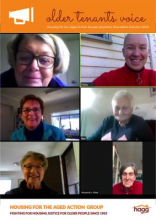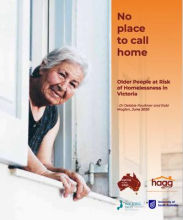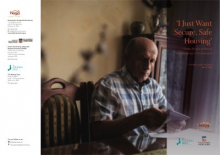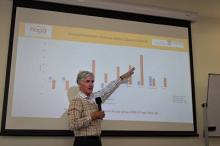The Ageing on the Edge - Older Persons Homelessness Prevention Project is extending HAAG’s work across Australia. In response to rapidly increasing housing problems facing older people, the project aims to raise awareness and improve services and housing for older people at risk of homelessness. More Information
State by State Breakdown
Ageing on the Edge Project 2021-2024
The Ageing on the Edge project is funded by the Wicking Trust, and is the key part of HAAG's national advocacy work.
The project aims to do two things -
- Awareness raising about the housing crisis and advocacy for the housing needs of older people.
- Establishing tailored services in each State and Territory that provide housing information and support for low income/asset older people, based on the proven Home at Last Model
Older people are the fastest growing cohort of homeless people in Australia. A variety of circumstances are making it harder for people to stay housed, including:
- Expensive and insecure private rental markets.
- Increasing numbers of people retiring with a mortgage or still renting.
- Insufficiency of public housing, Rent Assistance, Newstart and the Aged Pension.
- Family breakdown and elder abuse.
- Sell-offs of independent living units/residential villages
The problem is exacerbated as most older people have not previously interacted with the service system. They often do not recognise they are homeless or at risk and employ a range of coping mechanisms, e.g. housesitting and couch surfing. Furthermore, our research highlights gaps in service systems which lack integration and adequate funding and are not designed to meet the needs of older people.
This project will:
- Facilitate the voice of lived experience to inform policy design and delivery.
- Activate the sector and community to advocate for the housing needs of older people.
- Influence governments to invest in tailored housing information and support services.
- Empower older people to make informed choices about their housing future.
- Secure housing for those in crisis.
Ageing on the Edge Project 2016-2021 - What did the project aim to do?
We want a better housing deal for older people!
The project is being conducted in light of recent research that is warning of rapidly increasing housing problems facing older people.
The three main factors are:
- An ageing population
- Reducing rates of home ownership
- Significant increases in older people relying on rental accommodation to age-in-place in retirement.
Women are particularly vulnerable due to low paid and interrupted careers, lower rates of savings and superannuation. Most people affected have lived largely conventional lives but have, for a range of reasons, not aspired to or attained home ownership by the time they reach retirement. They need access to affordable housing to enable them to enjoy housing stability and affordability to ensure they can successfully age-in-place.
The project will increase awareness of older persons housing issues across Australia, improve older persons’ access to housing and ensure better availability of services that can help older people in housing difficulty.
These are some of the trends that are causing alarm
- More older people are renting in retirement
- Between 2011 and 2031 the number of Australians aged 65 years and over will increase from 2.4 to 5.8 million and represent 25% of the population.
- Between 2006-2011 people aged 55+ who own their home outright dropped from 63.8% to 60.5%.
- Between 1996 to 2007 public housing properties shrank by 32,000 while the population grew by 2.8 million people.
- In 2011, there were 173,000 Australians on public housing waiting lists.
- Between 2006-2011 the numbers of people aged 55+ living in private rental housing increased by 44% to total 334,000.
- The private rental market is insecure, expensive and poorly designed for ageing.
The facts paint a bleak scenario, but there are many opportunities for change. Whilst the solution is more affordable housing, the project also aims to improve access to current housing options for older people
- There are many affordable housing options for older people in Australia. However, information and access points and procedures are poorly co-ordinated.
- Accessing housing options needs a specialist service approach that understands the needs of older people. Older people are often facing homelessness for the first time in their lives and need assistance to navigate their way through the complexity of options to gain a housing solution.
- There are great models of specialist housing support services in Australia that can help older people at risk of homelessness, but they are fragmented and need to be expanded. For example, the Home at Last service in Victoria provides a one-stop shop housing information and support service for older people but it is the only service of its type in Australia.
- In most cases older people just need short term, one time, assistance to transition into affordable housing. They then generally go on to live happy productive lives with little ongoing support needed apart from standard home based aged care.
- Governments can invest in this area knowing that minor, one-off expenditure to help and older person transition into secure housing is cost effective expenditure compared to the ongoing expensive provision of crisis housing, hospital care and premature entry into residential aged care accommodation.
So where is the project beginning?
Let’s get a clear picture of the current housing situation for older people.
The project has begun a process of collecting and summarising relevant research and mapping the current housing environment by asking these questions:
- What housing options are currently available in Australia?
- How do older people discover and access affordable housing?
- What services exist to help older people find and navigate to affordable housing?
The answers will enable the project to identify current opportunities and gaps in housing and service provision and make recommendations for reform.
In addition to conducting research and mapping, the project aims to connect with and support current initiatives being developed across Australia. We have so far met a number of individuals and organisations that are passionate about change for older persons housing and we are available to assist with any work or lobbying that needs to be done. Other planned initiatives are:
- A national website as a clearing house for research and to bring people together who care about older persons housing.
- A National Older Persons Coalition on Housing (NOPCH). There is great interest across Australia to see reform of housing and related services for older people. We need a strong coalition to lobby the Commonwealth and State governments.
These and other activities will be promoted over the next year and beyond. If you would like to get involved with the project please get in touch

What is our vision for the future?
We want to see an Australian society that cares about the health and wellbeing of older people by ensuring that housing security, affordability and adaptability is a right not a privilege. The evidence shows that good housing provides an environment for good health, more disposable income and enables older people to contribute fully in society. This also means huge savings in avoidance of crisis housing and health services and premature entry into residential aged care accommodation.
Who is behind this Project?
The project is funded by The Wicking Trust as the project fits very well with one of the Trust’s priorities – assisting people to stay at home longer; including innovative models for supporting housing stability for older Australians at risk of homelessness. HAAG is sincerely grateful to The Wicking Trust for providing our organisations the opportunity to conduct this important work.


Ageing on the Edge Resource Library
The Ageing on the Edge Research Library houses the growing body of evidence of older people living in housing stress and homelessness, and studies into the causes, effects and solutions to this problem. As the problem grows in all Australian states, as well as around the world, we need more research to further understand the complexity of issues involved.







 "There is nothing like staying at home for real comfort."
"There is nothing like staying at home for real comfort."